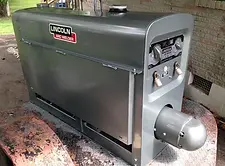HOW IDENTIFY YOUR LINCOLN SA-200/250 PIPELINE WELDERS
LINCOLN SA-200 "SHORT-HOOD"
The welder we know as the SA-200 goes back to 1930. They have a magneto ignition, because they originally had to be started by hand-cranking. This was originally designed too weld high pressure gas pipelines; it was designed to burn the 6010 Lincoln rod. Up until the SA-200 came along, all gas pipelines we welded with oxygen/acetylene welding, talked about welding in 100’ heat with a huge torch. During World War 2, for the war effort domestic welding machines were Lincoln, General Electric, Westinghouse, and Union Carbide. Hobart Brothers made welding machines for the military.



HOW IDENTIFY YOUR LINCOLN SA-200/250 PIPELINE WELDERS
Image “A ” above is known as the K-6090, you’ll hear them described as “blue dial” (blue face plate), “red face”, personally this tells me nothing about the machine. Years ago I had a contact at Lincoln and he worked on the line. He told me a machine would come down the line with paperwork. They would pull out a faceplate, from a bin; they had different colors, stamp the serial number and code number. Out the door she went! Number you need is the code number. All K-6090’s had codes from 3417 through 7242. The all had the R-57 vacuum idler and the “shaved side starter, image B. Normally you will find a Continental F-162 engine installed, I have seen F-163 engines in them also. They didn’t wait around, the put whatever engine they had laying around. On older machines you may find Hercules engines. For a short time they made some with Lycoming twin cylinder air cooled air plane engines. I’ve never seen one but I have seen pictures.

R-57 Vacuum Idle box
Information
Brushes: Information
Exciter Windings: Information
Rewound Armature: Information


Note: the welding
terminals are on
the front panel.
Information


LINCOLN SHIELD ARC SA200-F163 HEX BARREL

In the middle of the 1970s, Lincoln Electric made a significant upgrade from the original K6090 round barrel machine to the larger hex barrel. In my opinion, Lincoln has some of the best engineers in the industry. These machines were designed in an era of paper and pencil calculations, no computers, just slide rules. The armatures and hex barrels are almost identical, except for minor mechanical differences. The hex barrel was used on the 200, 250, and 300 amp machines. You need more amps; install an engine with more torque at lower speeds.
Starting with code number 7276 and ending with 9530, you have a K6090-SM. They can be easily identified by the hex barrel, Electronic idler system, and high-mount starter (mounted high on the block where the head and block meet). They standardized on the Continental F-163 engines; I have seen F-162 in them. Lincoln installed what they had.
The EPA killed the flat-head F-series engines, even in lawnmowers.

K6090 SM

ALTERNATOR
INFORMATION
OIL FILTER
INFORMATION
HIGH MOUNT
STARTER
INFORMATION
SIDE MOUNT TERMINALS
INFORMATION



LINCOLN SA-250-F163
The Lincoln SA250-F163 was a more powerful version of the SA200. Code numbers started with 8726 through 9660. It had an AC auxiliary power, and it looked very similar to the SA250 with a Perkins 3.152 diesel engine. The control panel looks the same except for the model and code numbers. It was never designed to be a "pipeline" machine. Nobody at Lincoln can tell me why they made this model. I believe it was to compete with the Miller Big 40 welders. It used the identical F-163 engine, it had a Prestolite distributor ignition, and a different governor. The concern is that they never welded as well as the original SA200. I have not been able to find a good image of one, but they look just like a SA250 diesel.


LINCOLN PIPELINER 200 G
In the mid-90s, the EPA came down hard on industrial gasoline engine manufacturers. The original engines found in Lincoln welding machines were older.
"long-stroke" engines. The diameter of the piston was much less than the length of the stroke. It gave more torque at low RPMs. When cars converted over to automatic transmissions, they needed more RPMs. Engine manufacturers developed "short-stroke". The piston diameter was less than the stroke. This slowed down the piston travel length. You could make a lighter, more compact engine. With an automatic transmission, you did need "low-end torque". You feed RPMs into the torque converter and get the required torque at various speeds. In a welder, you only have "idle speed" and "welding speed".
Lincoln was in a bind. They needed a gasoline engine that would pass the EPA and have enough torque at low speeds. Their best effort was the "Pipeliner 200g". It had a modified GM 3.0 cast-iron car engine. An excellent 4-cylinder automobile engine. They included a very reliable Delco HEI ignition system. Any auto parts store would have parts. They went to Zenith Corp. and had them design a one-of-a-kind throttle body fuel injection system. It was expensive, Lincoln would not support the engine, the technicians had no experience with any fuel injection, and Lincoln wouldn't help.
This was their last attempt to manufacture a water-cooled gasoline engine till the Continental TM-20 series was available.



LINCOLN CLASSIC 1 F-163 GAS ENGINE
Suppose you find a Lincoln Classic I with code numbers 9835, 9986, or 9999. You have what we call a transition machine; these are rare, very rare. The machines were manufactured starting in 1992. You have a DC SA200 in different sheet metal.
Please don't waste your time with your local Lincoln dealer; chances are, they don't know. When they call the factory, nobody seems to know anything that's not in the computer (which is a lot).
Email or give us a call at the info below.
.jpg)
LINCOLN CLASSIC 1 WITH TM-27 ENGINE
Starting with code numbers 10068 & 10069, Lincoln installed the TM-27 four-cylinder engine. These were the only codes with this engine. There were problems with rear main seal leaks. A change in the seal design resolved the issue. However, Continental Engine had undergone bankruptcy, been acquired, and its name had been changed to WIS-CON. Despite this, the damage to its reputation was irreparable.
Both Miller Electric and Lincoln dumped the engine.
You had a sexier SA-200, with all copper windings-whatever that means. I don't have any images of these code numbers, they look like a Classic 300 with a flat exciter cover

